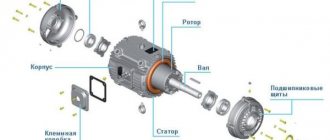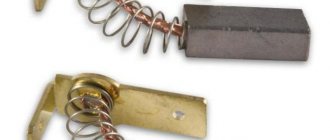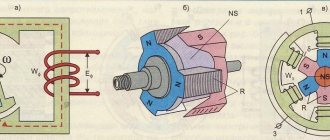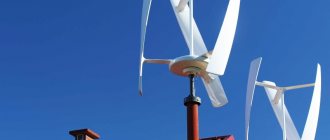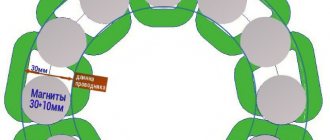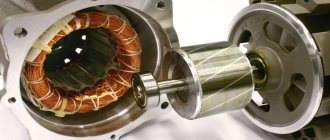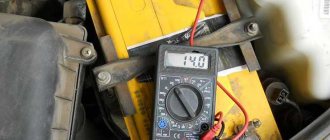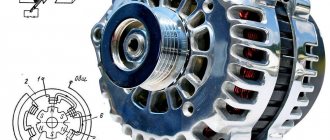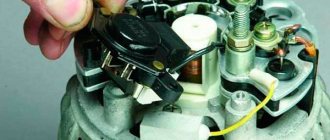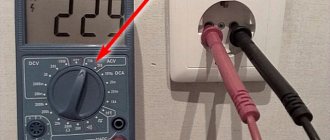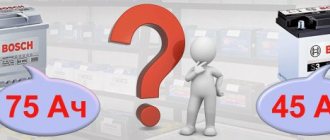The operation of a brushless electric motor is based on electric drives that create a magnetic rotating field. Currently, there are several types of devices with different characteristics. With the development of technology and the use of new materials characterized by high coercivity and a sufficient level of magnetic saturation, it has become possible to obtain a strong magnetic field and, as a result, valve structures of a new type, in which there is no winding on the rotor elements or starter. The widespread proliferation of high-power, low-cost semiconductor-type switches has accelerated the creation of such designs, simplified implementation, and eliminated many switching difficulties.
Principle of operation
Increased reliability, reduced price and simpler manufacturing are ensured by the absence of mechanical switching elements, rotor windings and permanent magnets. At the same time, an increase in efficiency is possible due to a reduction in friction losses in the collector system. The brushless motor can operate on alternating or continuous current. The latter option has a noticeable similarity to commutator engines. Its characteristic feature is the formation of a magnetic rotating field and the use of pulsed current. It is based on an electronic switch, which increases the complexity of the design.
What's better
A brushless motor has more advantages. The first is efficiency. It is 90%, while the analogue is only 60%. To put it simply, with the same battery capacity, inverter screwdrivers will last longer without recharging. This is an important characteristic if you have to work away from a power source.
The brushless model weighs less. This reduces hand strain and makes operation easier. Comparing the characteristics, we can say that an inverter screwdriver is more useful, efficient and reliable. The only problem is the cost.
Any tool will break sooner or later. If there is no need for precision, and the model is needed for infrequent household use, then many choose cheap brushed motors. However, when you need to buy a device that can last for a long time, it is recommended to spare no expense and buy a brushless screwdriver.
The screwdriver is selected based on preference. A brushless model is more useful and will be a better purchase if the user can afford to invest in the tool.
Position calculation
Pulses are generated in the control system after a signal reflecting the position of the rotor. The degree of voltage and supply directly depends on the speed of rotation of the motor. A sensor in the starter detects the position of the rotor and sends an electrical signal. Along with the magnetic poles passing near the sensor, the amplitude of the signal changes. There are also sensorless methods for establishing position, these include current passing points and transducers. PWM on the input terminals provides variable voltage level and power control.
For a rotor with permanent magnets, current supply is not necessary, so there are no losses in the rotor winding. The brushless motor for a screwdriver has a low level of inertia, ensured by the absence of windings and a mechanized commutator. Thus, it became possible to use at high speeds without sparking and electromagnetic noise. High current values and easier heat dissipation are achieved by placing heating circuits on the stator. It is also worth noting the presence of an electronic built-in unit on some models.
Device, pros and cons
Electric screwdrivers differ from each other in their power supply principle: there are mains ones with a power supply of 220 volts and portable ones equipped with a battery. In addition, models can be equipped with a striking mechanism. No other fundamental innovations have been introduced over the last decade, with the exception of one – a brushless mechanism.
Brush screwdriver
The most common type - a commutator motor - is installed on most models. Its operating principle is simple: the windings are switched mechanically and in the armature chain. The contacts are a collector, and energy is transferred thanks to spring-loaded brushes.
Strengths:
- old, reliable technology;
- low cost of parts;
- simplicity and clarity of repair.
Flaws:
- collector lead to energy losses, which means lower efficiency;
- occurrence of sparks, heating of the motor;
- interdependence of speed and torque;
- power losses during reverse operation;
- rapid wear;
- loss of speed under load.
The brush motor has many weaknesses, but they can be justified by cheap components and ease of repair - this is a more affordable option.
Brushless screwdriver
With inverter models the situation is the opposite. They are more efficient and more suitable for the job. Advantages:
- the ability to control the rotation speed: the user receives a wide range of settings - the rotation can be adjusted, depending on the nature of the work and the surface being processed.
- the engine does not provide a commutator-brush assembly, which means that the tool will break less often (if it is used correctly), and maintenance will not cause problems due to the simplicity of the design;
- models cope more effectively with increased load caused by high torque;
- battery power, if it is a portable screwdriver, is consumed more economically;
- higher efficiency - brushless motor produces 90%;
- the ability to operate the tool in a hazardous environment: near gas mixtures and flammable substances (the inverter motor operates without a spark);
- the same power is maintained in forward and reverse mode;
- increased load does not lead to a decrease in rotation speed.
Weak sides:
- high price;
- the large size of the body, when compared with brush models, makes it difficult to work at arm's length or penetrate into tight spaces.
When choosing, it is important to pay attention to the type of battery inside the screwdriver. If you think correctly, then the tool will serve the owner faithfully for many years without loss of performance.
Magnetic elements
The placement of the magnets can vary depending on the size of the motor, for example on the poles or throughout the rotor. The creation of high-quality magnets with greater power is possible through the use of neodymium in combination with boron and iron. Despite the high performance, the brushless motor for a permanent magnet screwdriver has some disadvantages, including the loss of magnetic characteristics at high temperatures. But they are more efficient and have no losses compared to machines that have windings in their design.
The inverter pulses determine the rotation speed of the mechanism. With a constant supply frequency, the engine operates at a constant speed in an open-loop system. Accordingly, the rotation speed changes depending on the level of the supply frequency.
What is a servo motor?
The CNC servo motor is an electric motor with position feedback. It receives a control signal, by which it changes the position of the rotor by a given amount, monitors this change and controls the power parameters. The presence of feedback is the main difference between servomotors and stepper motors, which use a step counting system to determine movements.
The servo drive consists of the following elements:
- electric motor;
- rotor position sensor (Hall sensors or encoders are most often used in CNC machine drives);
- control signal converter;
- power supply (inverter or frequency converter).
The operating principle of a servomotor with the simplest control circuit is based on comparing the specified movement with the readings of a feedback sensor. Voltage is supplied to the windings through a relay. CNC motion drives use more complex control circuits based on logic controllers. They have a number of advantages that are important for the operation of the machine:
- the ability to select power in accordance with the tasks;
- automatic compensation of backlashes, gaps associated with wear, seasonal and operating temperature deformations;
- instant detection of failure - jamming, failure of electronic components;
- high travel speeds not available for stepper motors.
Characteristics
The valve motor operates in set modes and has the functionality of a brush analogue, the speed of which depends on the applied voltage. The mechanism has many advantages:
- no changes during magnetization and current leakage;
- correspondence between the rotation speed and the torque itself;
- speed is not limited by centrifugal force affecting the commutator and rotor electrical winding;
- there is no need for a commutator and excitation winding;
- The magnets used are lightweight and compact in size;
- high moment of force;
- energy saturation and efficiency.
How does a brushless motor work?
The 1970s saw a breakthrough in semiconductor electronics that eliminated the commutator and brushes in DC motors. In a brushless motor, the amplifier replaces mechanical contact connections. The electronic sensor understands the rotation angle of the rotor and is capable of monitoring semiconductor switches. The elimination of sliding contacts led to a decrease in friction in the mechanism, and therefore an increase in service life.
The brushless motor in a screwdriver is much more efficient and suffers less wear and tear. It is also much quieter and provides high torque. The internal elements are completely closed, so that dirt and water do not get inside. The efficiency of converting energy into force allows for high efficiency.
The rotation speed is affected not by centrifugal force, but by voltage, so the engine can operate in a given mode without interruption. If current begins to leak or the motor becomes magnetized, performance will not be affected and the speed will not lag behind the torque.
When operating the mechanism, there is no need to use a commutator or winding, and the magnet is much smaller, both in weight and in size, when compared with a brush competitor.
This solution is used in screwdrivers whose power does not exceed 5 kW. It is unwise to install them in models with large parameters. The magnets inside the case are sensitive to magnetic fields and strong heat.
The difference between a brushed and brushless screwdriver in the principle of motor operation:
- The current is switched not in the rotor, but in the stator windings. There is no coil on the armature; the magnetic field is formed thanks to special magnets inside the housing.
- The moment when electricity is required is determined by built-in sensors. They work on the principle of the Hall effect. DPR pulses and speed control signals pass through the built-in processor, where they are formed. This is called a PWM signal.
- The generated pulses are sent in order one after another to inverters or, more simply, amplifiers - they increase the resulting current. Their outputs are connected to the winding on the stator. Inverters are needed to switch the current generated in the coils, following the pulses that are supplied from the internal processor node.
As a result of the described process, a magnetic field is formed, which is associated with that around the rotor. The anchor begins to rotate - the tool works.
Usage
The brushless permanent magnet DC motor is found mainly in devices with power in the range of 5 kW. In more powerful equipment their use is irrational. It is also worth noting that the magnets in motors of this type are particularly sensitive to high temperatures and strong fields. Induction and brush options do not have such disadvantages. The engines are actively used in electric motorcycles and automobile drives due to the lack of friction in the commutator. Among the features, it is necessary to highlight the uniformity of torque and current, which ensures a reduction in acoustic noise.
